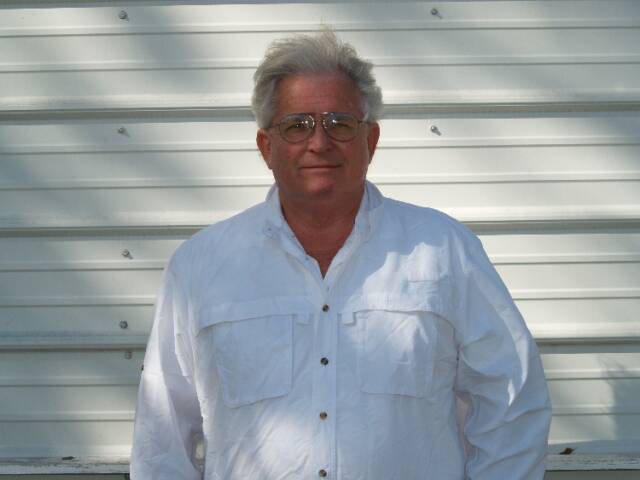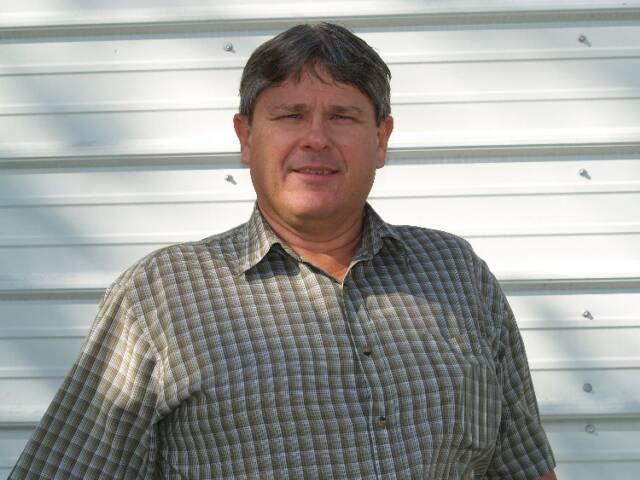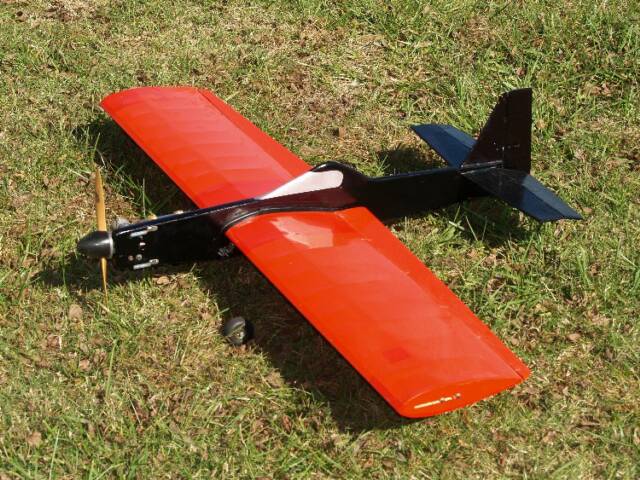Subject: The great 10-6 propellor test
Starting Date: August 2008
Location: Reeves Field, Catoosa, Oklahoma
Joe Gilbert and I decided to test 10-6 props for efficiency. The airplane
used was a trimmed out stock SIG Twister, with a very good Fox .35, (One that can
turn a Rev Up 10-6 EW with authority) uniflow fuel tank, burning Fox Fuel.
(29% castor, 5% Nitromethane) Line length was 60 feet eyelet to eyelet.
The needle valve was Not readjusted between fights. The airplane was
flown on 5 different days to test all the props. The first flight of each day
was always flown with the RSM 10-6 to ensure that engine performance
was adequate. Our conclusions will apply to the OS .35S, Mccoy .35 Redhead
and Fox .35 stunt engines that are in good operating condition.
A lot of people have a lot of old props. Some are worth trying, and some aren't.
That's why we used a bunch of old props on this test. When we checked the pitch
on the props, only one side was checked in order to save time. We also did not shorten
or lengthen the flying lines during the tests due to time constraints.
The prop pitch is given in inches. The lap time is given in seconds.
We have three definitions put in place here so that you can understand our conclusions.
1.Drive: The ability of an airplane to fly through a corner without loosing excessive speed.
2.Stability: The ability of a prop to positively influence level flight.
3.Break: The process of an engine going from four stroke to two stroke.
De Hill
First Tier Propellors: Any of these props will work for the OS .35S, Mccoy .35 Redhead,
and the Fox .35 Stunt engines.
1. RSM 10-6- 5.53 lap time- Outstanding - Excellent line tension and drive
through corners. The engine four stroked hard and broke at the right time.
This prop seemed to make the plane more stable in level flight and
when the corner was released the plane would fly out of the corner with
authority. pitch: 5.55
2. Rev Up 10-6EW- Very Very good prop. Good line Tension, Stability and Drive.
Almost as good as the RSM. This Fox pulled it very well strong four stroke run
beeping to two at top of maneuvers. The RSM outperformed the 10-6 EW only
in the hour glass at the third turn. pitch: 5.6
3. Brodak BY&O 10- 6 -lap time: 5.31 - not quite as much drive or as stable as
the RSM in level flight, line tension is good, prop is stable in the reverse wingover.
pitch: 6.0
4. APC 10-5 - 5.65 lap time - Very Good Stability, Drive, and Break. A good prop to
bolt on and get acceptable performance. Be sure and sand off the sharp edges! Pitch: 5.5
5. Woodcraft 10-6 Wood paddleblade: 5.74 lap time - Great stability, good Drive,
loaded engine nicely, and had an excellent Break. Pitch: 4.6 -Very Rare prop.
6. EVO 10-6 plastic: 5.44 lap time - Good Stability Drive and Break. Slightly lower
line tension than the others in this class. Pitch: 5.7
7. Top Flight 10-6M: 5.56 lap time- very good prop. Could be made to work
satisfactory, it and the APC were close in performance. pitch: 5.95
8. Top Flight 10-6 Wood: lap time 5.5 About the same as the Top Flite Super M.
Pitch- 5.95
Any of the above props will work well with slight changes in line length and needle setting.
Second Tier Propellors : Some of these props MAY work for you.
9. Rev Up 10-6W - lap time - 5.75 - Good Stability. Not quite as good as the
Top Flight 10-6 M. pitch: 6.0
10. Woodcraft Pattern King 10-6 - Very close to the Rev Up 10-6 W. pitch: 5.7
11. TMHK Super Thrust Square Tip 10-6. Very Good Drive. Very crude looking prop.
It shouldn't work as well as it does. Rare prop. pitch: 5.7
12. Super Dynamic - 5.56 lap time - like a Rev Up 10- 6 W. pitch: 5.7
13.Woodcraft Carbon Fiber Paddle Blade: lap time: 5.81 - Low line tension,
Middle Drive, Good Stability, Did not load engine greatly. Prop is undercambered.
If the lines had been shortened, or the engine leaned out, this prop could have been
a contender. We think George Aldrich used to sell this prop.
14. Top Flight Power Point 10-6- lap time: 5.31 - Good Stability, Line
tension and drive. pitch: 6.0
Third Tier Propellors
15. REV Up 10-6 - 5.65 lap time - a fairly good prop. Might be ok on
couple feet shorter lines. pitch: 5.55
16.Power Prop 10-6 (Top Flight) lap time 5.34 - An OK prop, if lines were shortened
and the engine was leaned out. pitch: 6.1
17. Thunder Tiger 10-5.5 - 5.50 lap time. About like a Rev up 10-6 .
pitch: 5.9
18. TCI 10 - 6- 5.40 - Same as a Thunder Tiger 10-5.5- pitch:5.95
19. Top Flite plastic 10-6 lap time 5.5 - Drive not good- probably due to blade flex.
pitch: 5.55
20. Master Airscrew 10- 6 (wood) lap time 5.35 - Good Drive; squirted out of the
turns and corners better than expected. Pitch: 5.9
21. Master Airscrew (plastic) Lap Time: 5.25 - Good stability, less drive than the
MA plastic prop. Pitch:5.8
Fourth Tier Props____________________________
These are props that don't work good at all on a Fox .35 (or similar) Engine.
They may work on a larger displacement engine.
22. Zinger 10-6 - lap time: 4.75 - Not Stable - No Drive - Good line
tension. pitch: 5.96
23. Zinger 10-6 W - lap time: 4.84 - Unstable - Good line tension except
in the square eights - No Drive - loads engine heavily. With richer engine
setting it may be OK. pitch: 6.10
24. Zinger 10-6 X W - lap time: 4.91- Good line tension except it slowed
down in the Square eight, prop heavily loaded the engine - Good Stability -
pitch: 6.7
25. BY&O 10-6 (made in Oregon) 5.57 lap time. Slowed in manuvers line
tension not acceptable. pitch: 5.6
26. X-Pert 10-6: 4.95 lap time- Loaded the Fox very hard and leaned it out
excessively during corners and turns. pitch: 6.0 -Very old and rare prop.
27. Tornado Plasticote (Pressed Wood) 10-6 - lap time 5.31 - no Drive,
but Stable - pitch: 6.5
28. Nylon Plastic Tornado 10-6 - lap time - 5.6 - No Good! We think the
blades flex too much. pitch: 5.5
29. OS 10-6 - (Wood Round Tip) lap time 5.91 - Bad Prop - no Drive- It has a
symmetrical airfoil (!) pitch: 4.027.
30. Tatone Twister 10-6 - 6.08 lap time - crude finish, ran in two stroke
mode more than any other - very inefficient. pitch: 5.5
31. OS 10- 6 (Square Tip) lap time 4.9. Unstable, No drive, No line tension - No Good!
pitch: 6.0
32. Rite Pitch 10-6 - lap time: 4.8. Loaded engine excessively - Drive not good. Pitch : 6.0
Designed long ago for Ignition engines.
33. Joyce plastic replaceable blade propeller. lap time 7.3 -Just a bad prop. A collector's item only.
pitch: 4.95
34. Roberts Super Special 10- 6 - lap time 6.0 - No Good at all. Very little drive, or line tension.
A good prop to give away. Prop is poorly made.
De asked me to do this test of props with him.I accepted the challenge, but did not realize how much I would learn nor how much I didn't understand. This test is not an all inclusive, absoloute test of propellors. However, you can say that on this date, and on this plane and engine, the top eight props were better than the other 17.
We flew the airplane in the following manuvers; Reverse Wingover, Horizontal Eights, Horizontal Square Eights, Vertical Eights, Hourglass, and the Overhead Eights. It is amazing how quickly you can tell if a prop is going to be good or not.Just in the reverse wingover you can already tell if the prop is going to be good or not.
The Top Tier props are very good, and in my opinion, not a lot of difference between any of them. The RSM prop had the best performance, but on a different airplane or with different line lengths,one of the other top tier props may have been better.
It doesn't make sense that some props make the airplane more stable in flight, but the more we tested the more we found that stiffer props give more stability; but not necessarily more Drive or more Line Tension.
How can one prop have more line tension at 5.65 seconds per lap than another prop has at 5.15? There is a whole lot to trimming an airplane. Engine tuning is very important, and the prop selection can make or break the airplane's performance in the pattern.
The finish on the propellor blades did not make as much difference as I thought it would. The poly-gloss finish was not necessarily better than a plain varnish finish. The shape or thickness of the prop was not an indicator of performance. We tested the TMHK Superthrust 10-6 prop with thick square tips that looked like they had been beveled on a disc sander. The prop performed very well. The old saying "You can't judge a book by looking at the cover" may very well be true of props also.the one prop that fooled us was the Woodcraft Paddle Blade. It looked like something out of the 1940's.
On two foot shorter lines, it could have been on of the best props. George Aldrich sold these for a while, but whether he had anything to do with the design is not known.
One other thing we found was that a prop can either richen or lean out the engine! It just depends how much load the prop adds to or takes away from the engine.
If you are going to run a Fox .35 Stunt engine, an OS .35s, or a Mccoy Redhead, the best props you can buy are the RSM , Brodak BY&O, Top Flite Power Point , and the Evoloution EVO 10-6 props. The APC 10-5 is very good, and performs like a 10-6 prop. All of these props are worth testing to be sure
that you are getting the best performance out of your airplane and engine. If you have some old props lying around, you may be able to make good use of them. Check our test results for your prop, and you will know if it is worth trying or not.
We don't claim to know everything about Fox engines. But what this has taught me is: don't quit trimming when the airplane is "good enough". Try all the props out that you can get your hands on, and don't be afraid to change line lengths to help prop and engine to work together for the best overall result.
Joe Gilbert



